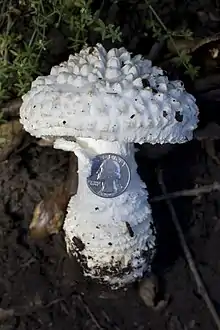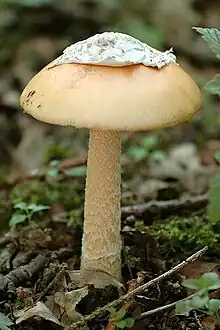Amanita magniverrucata
Amanita magniverrucata, commonly known as the pine cone amanita,[1] or great pine jewel, is a species of agaric mushroom in the family Amanitaceae. First described scientifically by American mycologists Harry Delbert Thiers and Joseph Ammirati in 1982, it is mycorrhizal and associates with the tree Pinus radiata.[2]
| Amanita magniverrucata | |
|---|---|
 | |
| Young specimen | |
| Scientific classification | |
| Domain: | Eukaryota |
| Kingdom: | Fungi |
| Division: | Basidiomycota |
| Class: | Agaricomycetes |
| Order: | Agaricales |
| Family: | Amanitaceae |
| Genus: | Amanita |
| Species: | A. magniverrucata |
| Binomial name | |
| Amanita magniverrucata Thiers & Ammirati | |
| Amanita magniverrucata | |
|---|---|
| Gills on hymenium | |
| Cap is convex or flat | |
| Hymenium is free | |
| Stipe has a ring and volva | |
| Spore print is white | |
| Ecology is mycorrhizal | |
| Edibility is unknown | |
While its edibility is unknown, it may be poisonous,[3] as are many Amanitas.
See also
| Amanita magniverrucata | |
|---|---|
| Gills on hymenium | |
| Cap is convex or flat | |
| Hymenium is free or adnate | |
| Stipe has a ring and volva | |
| Spore print is white | |
| Ecology is mycorrhizal | |
| Edibility is unknown or poisonous | |
References
- Arora, David (1986). Mushrooms demystified: a comprehensive guide to the fleshy fungi (Second ed.). Berkeley: Ten Speed Press. ISBN 978-0-89815-169-5.
- Thiers HD, Ammirati JF. (1982). "New species of Amanita from western North America". Mycotaxon. 15: 155–66. Retrieved 2010-07-10.
- Phillips, Roger (2010). Mushrooms and Other Fungi of North America. Buffalo, NY: Firefly Books. p. 24. ISBN 978-1-55407-651-2.
This article is issued from Wikipedia. The text is licensed under Creative Commons - Attribution - Sharealike. Additional terms may apply for the media files.
